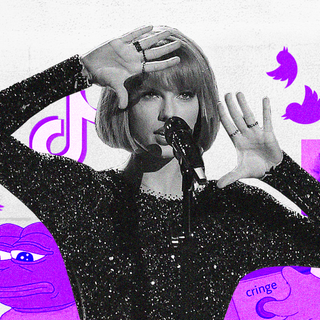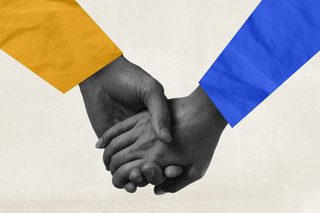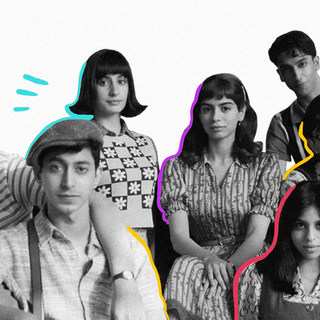
The Cultural History of Holding Hands
The ubiquity of the gesture’s associations with affection and support has inspired many studies, but its origin still remains unknown.

Holding hands is often an important milestone of physical intimacy in teenage — and, perhaps, even young adult — relationships. No wonder then that many of us have, at some point in our lives, gushed, “We held hands today!” Movies, too, will often shift to romantic background music, or break into a song the moment a couple slowly entwines fingers together while strolling down a road, often in the rain. The association between romance and holding hands is so strong, in fact, that research suggests people in same-sex relationships who aren’t publicly outside the closet actively avoid holding hands outside safe spaces. They fear it would automatically give away their sexual orientation — leading to harassment, or even assault.
Holding hands doesn’t just have a romantic connotation, though — it’s also associated with support, solidarity, affection, friendship, and reconciliation. Think: a friend just placing their hand on yours to reassure and console you, or offer you support. In 2005, former U.S. President George W. Bush and Crown Prince Abdullah of Saudi Arabia held hands while taking a stroll together — reportedly, since it is a “sign of friendship and respect in Saudi Arabia for men to hold hands while walking.”
The pervasiveness and timelessness of the gesture’s socio-cultural associations, though, makes one wonder how they came to be — how did holding hands acquire such an overwhelmingly positive undertone?
To some extent, perhaps, science may have a role to play here — consciously or unconsciously. “[H]olding hands can reduce activity in a part of your brain called the hypothalamus, which is responsible for regulating part of the body’s stress response, and that the degree to which this is true corresponds with better general health and wellbeing,” James Arthur Coan, a neuroscientist and psychology professor at the University of Virginia, who teaches a course titled ‘Why We Hold Hands,’ had explained in 2020. “It’s such a simple activity, and yet it also has great power.”
Research has also shown that holding hands can reduce levels of cortisol, or “the stress hormone,” and release oxytocin, or “the cuddle hormone.”
Related on The Swaddle:
Why Kissing Became Our Go‑To Way To Express Affection
Interestingly, though, it’s not just humans who hold hands; some chimpanzees do it too, as do otters. Frans de Waal, a Dutch primatologist and ethologist, who observed the behavior of apes, explained to NPR that “if one ape starts using a gesture in a unique context, others in the group are apt to copy it, leading to what’s called ‘cultural transmission.’ The group develops its own dialect of gestures.” Is this how holding hands became a universal gesture of goodwill among humans too? Coan believes it’s “highly likely” that the gesture is “powerfully shaped by culture.”
When did the gesture truly become recognized might be difficult to pinpoint, though? According to Peter Lukas, editor at ElizabethanDrama, the expression “holding hands” may have first appeared in George Best’s A True Discourse of the Late Voyages of Discouerie in 1578, while the expression “holdinge hande” appeared in the 1555 print of Richard Eden’s English translation of Pietro Martire d’Anghiera’s The Decades of the Newe Worlde… Conquestes of the Spanyardes.
The ceiling of the Sistine Chapel, painted by Michelangelo even earlier, between 1508 and 1512, also depicts hand-holding.
There is also an engagement ring at the Nantwich Museum in England, dating back to the 13th or 14th Century, which appears to have been shaped to resemble two hands clasped around each other. In fact, rings like this one were rather common in history — so much so that they have their own name: “fede-rings,” derived from the Italian phrase “mani in fede,” which means “hands clasped together in faith.”
It is pertinent to note, however, that the social undertones surrounding hand-holding differ across cultures. Unlike in Saudi Arabia, for instance, “we don’t often see men holding hands in the rural South. Or on a ranch in Texas. Good ol’ boys tend to keep other guys at arm’s length — unless they’ve just scored a touchdown,” an article reads.
Related on The Swaddle:
The Best Way to Hug Someone, According to Science
Coan alludes to other possibilities behind the almost instinctive ubiquity of the gesture, too — beyond just the theory of it being shaped merely by culture. “[H]andholding is so pervasive that some other possibilities must be considered. Among these are that handholding is somehow encoded in our genome. I find this unlikely,” he notes, adding, “I think a better explanation is simply that humans must know that they are safely embedded in a network of supportive social relationships if they are to survive and thrive, and handholding is such a strong way to signal that we all — most of us — just naturally do it.”
Becky Spelman, a psychologist, also alluded to the ingrained human intuition about holding hands. Speaking to Cosmopolitan two years back, she said, “babies are born with a grasping reflex and will curl their tiny hands around any finger placed in their palm. Instinctively, they are already trying to hold hands.”
The instinct is, perhaps, driven by the sense of calm and security holding hands can bring — besides being a pain-reliever, too, as past research has established.
But not everyone likes holding hands, right? “Many have told me that they aren’t comfortable holding hands. I encourage them to give it a try with someone they trust very much,” Coan noted, adding, “No one has told me that this has backfired for them.”
We don’t know whether anyone he spoke to lived with haphephobia (a fear of being touched), or was a neurodivergent individual who found touch uncomfortable and overwhelming, or experienced social anxiety so high that it made them averse to physical contact. If he did, though, then holding hands — unlike hugging or kissing — might just be the most universal form of expressing affection.
Devrupa Rakshit is an Associate Editor at The Swaddle. She is a lawyer by education, a poet by accident, a painter by shaukh, and autistic by birth. You can find her on Instagram @devruparakshit.
Related


The Mysterious Affair of the Cultural Decline of Whodunits
